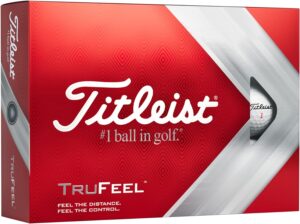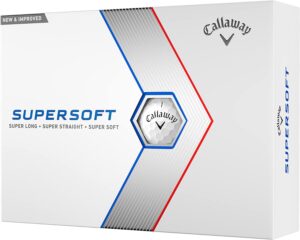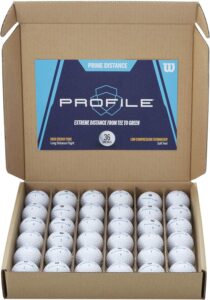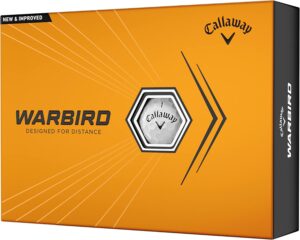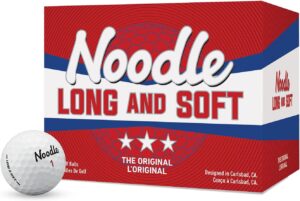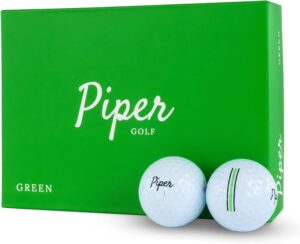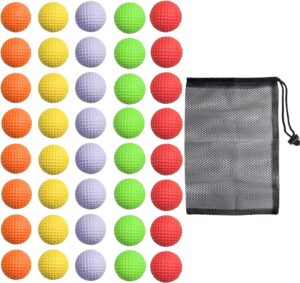Golf can be an intimidating sport to start as a beginner. With so many different clubs, rules, and techniques to learn, it’s easy to get overwhelmed. One key piece of equipment that is important for beginners to understand is golf balls. The type of golf ball a beginner uses can greatly affect their game and how much enjoyment they get out of learning.
When starting out, beginners generally benefit from using softer golf balls that are more forgiving. Harder balls meant for experienced golfers can be frustratingly difficult to control for a newcomer. Softer balls compress more on impact, resulting in straighter shots and fewer slices or hooks. Distance is also reduced, allowing beginners to work on fundamentals without getting discouraged. In this buyers’ guide, we’ll recommend the best golf balls for beginners and explain what to look for when making a purchase. The right ball choice can really help make learning golf more fun!
1. Titleist TruFeel Golf Balls for Beginners
The Titleist TruFeel golf ball is designed to deliver an ultra-soft feel, longer distance, and excellent greenside control. Built with beginner golfers in mind, the large, fast core generates low driver spin for added distance off the tee. The high-performance dimple pattern optimizes aerodynamics for a penetrating trajectory. The reformulated TruFlex cover is Titleist’s softest yet, providing superior shot-stopping control around the greens.
Weighing just 1.6 ounces, this two-piece ball offers trusted Titleist quality and consistency. Available in white, yellow, and matte red, the TruFeel provides optimal visibility for tracking shots. The combination of soft feel and low driver spin makes this ball ideal for new players seeking to maximize distance without sacrificing feel. With renowned Titleist performance at an affordable price point, the TruFeel delivers everything beginners need to play their best game.
Pros And Cons
2. Callaway Golf Supersoft Golf Balls for Beginners
Designed for high performance with an ultra-soft feel, the Callaway Golf Supersoft is an excellent choice for beginner and novice golfers. The advanced low compression core generates fast ball speed for long distance off the driver, while still providing soft feel and control around the greens. The new softer Tri-ionomer cover further increases short-game spin and control.
Weighing only 1.4 ounces, the Supersoft promotes straight, penetrating trajectories and reduced hooks/slices. Ideal for slower swing speeds, this ball delivers optimized aerodynamics and carry. Durable construction withstands the mishits common with beginners. Trusted by golfers at all skill levels, the Supersoft maximizes performance for new players looking to develop consistency and confidence.
Pros And Cons
3. WILSON Profile Distance Golf Balls for Beginners
Designed for maximum distance and soft feel, the Wilson Profile Distance is an ideal choice for beginner and novice golfers seeking more yards off the tee. The high-energy core generates fast ball speed for effortless distance, while the low 60 compression rating ensures a soft feel on shots. The specially engineered ionomer cover reduces spin for straighter shots, resulting in fewer hooks and slices.
Weighing just 1.6 ounces per ball, the Profile Distance promotes a penetrating ball flight even in windy conditions. The matte finish helps reduce glare and makes ball tracking easy. Packaged in quantities of 12 or 36 balls, the Profile Distance offers trusted Wilson quality at an affordable price point. With its combination of low driver spin, soft feel, and durable ionomer construction, this ball delivers optimal performance for new players working to develop consistency.
Pros And Cons
4. Callaway Warbird Golf Balls for Beginners
The Callaway Warbird is engineered for maximum distance and speed for beginners and high handicap players. Its high-energy core delivers fast ball velocity off the clubface, while the HEX Aerodynamics promote low drag and optimal launch conditions. Weighing 1.5 ounces, the Warbird generates penetrating trajectories and reduced spin for longer carries. The large, soft core ensures great feel and compression. The ionomer cover provides greenside control and soft feel on pitch shots and chips.
Designed as an affordable 2-piece distance ball, the Warbird is ideal for beginners able to swing aggressively and maximize their driver distance. The combination of speed-inducing core, drag-reducing dimples, and soft feel make the Warbird one of Callaway’s most popular balls for new players seeking to add yards off the tee. It provides the forgiveness needed to develop proper swing techniques.
Pros And Cons
5. Nitro Golf Golf Balls Nitro for Beginners
Designed for maximum distance and soft feel, Nitro Golf’s Nitro ball features a proprietary hot core that generates fast ball speeds for added yards off the driver. Besides reducing drag, the 352 dimple pattern increases lift for penetrating trajectories. With a 70 compression rating, this ball ensures soft feel, even on slower swings. Furthermore, the durable Surlyn cover provides excellent scuff and cut resistance.
Weighing 1.62 ounces, this ball promotes low driver spin for straighter shots. Additionally, a semi-translucent white finish enhances visibility. Conforming to USGA standards, this ball suits golfers at all skill levels seeking peak performance on a budget. With its aerodynamic design and hot core, this ball allows beginners to maximize potential distance without breaking the bank.
Pros And Cons
6. TaylorMade Noodle Golf Balls for Beginners
The TaylorMade Noodle Long & Soft is engineered to deliver maximum distance and an ultra-soft feel for beginner to intermediate golfers. Besides, the high-energy reactive core generates fast ball speeds for long carry off the driver. In addition, the 342 dimple design reduces drag for penetrating, sustained trajectories. Furthermore, the ultra-soft Ionomer cover provides a smooth feel around the greens and helps add spin on pitch and chip shots.
Weighing just 1.5 ounces, the Long & Soft promotes optimal launch conditions. With its 22 compression rating, this ball ensures an extremely soft feel even for slower swing speeds. Moreover, the durable Ionomer cover resists scuffs and cuts. TaylorMade’s trusted quality shines through in this 2-piece distance ball ideal for newer players able to swing aggressively.
Pros And Cons
7. Piper Golf Premium Golf Balls for Beginners
The Piper Golf Premium is a 2-piece distance golf ball engineered for high handicap players and beginners seeking maximum yards and straighter shots. In addition, the fast core generates low spin and high launch for added carry off the tee. Furthermore, the DuPont Surlyn cover provides durability and promotes straight trajectories with minimal hooks/slices. Moreover, the 70 compression rating ensures soft feel on any swing.
Weighing just 1.68 ounces, the Premium delivers an ideal trajectory that combats wind. The matte green finish aids in quick alignment and visibility. Piper Golf specially designs this ball for players with swing speeds under 90 mph. With its combination of explosive distance, low driver spin, soft feel, and optical alignment aid, the Premium allows beginners and high handicappers to play more consistently.
Pros And Cons
8. ACCUFLI Max Soft Golf Balls for Beginners
The Accufli Max Soft golf ball delivers an exceptionally soft feel and superior distance for beginners and high-handicap golfers. Besides, the low compression, hyper-elastic core generates fast ball speed for added yards while providing a soft response at impact. In addition, the hybrid ionomer cover with aerodynamic dimple design reduces drag and optimizes launch conditions for a penetrating ball flight. Available in vibrant fluorescent matte finishes, the Max Soft offers excellent visibility and tracking.
Weighing just 1.6 ounces, this 2-piece ball minimizes sidespin for straighter shots. The alignment aid allows for improved accuracy. Trusted for its quality, the Max Soft suits slower swing speeds under 90 mph. With its combination of explosive distance off the tee, soft feel, and shot-stopping spin, this ball enables beginners and recreational players to maximize their performance.
Pros And Cons
9. Jaya Foam Golf Practice Balls for Beginners
The Jaya Foam Golf Practice Balls provide a safe, limited-flight alternative to real golf balls for indoor and outdoor training. Made of durable resin PU rubber, these soft foam balls mimic the feel of striking a real ball while eliminating damage risks. The realistic dimple textures impart true ball flight with lower distance, allowing golfers to groove proper impact techniques.
Weighing just 0.5 ounces, the foam absorbs clubhead speed for controlled shots. Bright colors make these balls easy to spot in grass. The 12 or 32-pack options with a carry bag allow for convenient practice anywhere. Ideal for beginners, children, and off-season training, these balls build confidence by removing fears of errant shots.
Pros And Cons
10. Bac-kitchen Foam Golf Practice Balls for Beginners
The Bac-kitchen Foam Golf Practice Balls provide a versatile training tool for developing golf skills indoors or out. Made from durable, soft resin PU rubber, these lightweight balls mimic the feel of real golf balls with lower flight for safer practice. Besides, the 40-pack includes 5 vivid colors to liven up range sessions.
Weighing just 0.5 ounces, the foam construction absorbs speed to reduce mishit risks, yet provides realistic feedback. Moreover, the dimple patterns impart true ball flight with backspin, helping groove proper impact and trajectory. Golfers can hone their short game or dial in their driver form without fear of property damage. Ideal for beginners, children, and off-season training, these balls build confidence by removing hesitation over errant shots.
Pros And Cons
How to Choose the Best Golf Balls for Beginners?
Learning to play golf can be challenging enough without having to figure out what type of ball to use. As a beginner, choosing the right golf ball is important in setting yourself up for success on the course. This guide will walk you through the key factors to consider when selecting golf balls as a novice player.
1. Focus on Control Rather than Distance
When first starting out, you’ll want to prioritize control over maximum distance. Beginner golf balls are designed to be lower compression, meaning they don’t travel as far when struck but are more forgiving. Using a softer ball helps reduce hooks and slices, allowing you to work on developing solid contact and keeping the ball in play. Distance will come later as your swing improves.
2. Pay Attention to Spin
Spin affects the ball’s flight and run once it lands. For beginners, a ball with lower spin will be more forgiving than a high-spin ball, which requires greater swing speed control to manage. Most balls for novices have an ionomer cover that reduces spin and helps new players achieve straighter, more accurate shots.
3. Consider Durability
As you’re learning, you’re bound to lose some balls in the woods or water hazards. While you don’t need a indestructible ball, do look for one with decent cut-resistance that won’t scuff or damage easily. Two-piece construction balls are typically most durable for newbies. Stay away from softer three-piece balls until you have better command of your swing.
4. Get the Right Compression Rating
Compression indicates how much a ball compresses at impact. Beginner golf balls range from 50-80 compression, whereas balls for advanced players are around 100. Lower compression reduces distance but allows more control. Go for a 70-80 compression ball as a happy medium while you continue to improve your skills.
5. Don’t Break the Bank
There’s no need to spend a fortune on golf balls as a novice. Affordable, beginner-level balls will suit you fine for now. Once you advance, you can invest in higher-end balls designed for lower handicaps. Save your money for lessons early on.
With the right ball for your skill level, you’ll enjoy the game much more and develop faster. Test a few beginner balls to see which provides the ideal combination of control, accuracy, affordability, and durability. Don’t be afraid to ask for input at the pro shop as well. The key is finding the ball that best complements your swing as a work-in-progress. Patience and practice will pay off down the road. Happy golfing!
Frequently Asked Questions When Picking the Best Golf Balls for Beginners
1. What compression rating is best for beginners?
Beginners should look for golf balls with a compression rating between 70-80. Lower compression balls are softer and compress more on impact. This makes them more forgiving for slower swing speeds and helps reduce hooks/slices. A compression around 70-80 is a good balance of control and distance.
2. Should I get a 2-piece or 3-piece golf ball?
2-piece golf balls are best suited for beginners. They are more durable and provide good distance at slower swing speeds. 3-piece balls feature a softer cover that generates more spin, which beginners tend to struggle controlling. Stick with a sturdier 2-piece ball while you’re learning.
3. What type of cover is optimal for novice players?
Ionomer covers are ideal for beginners. Ionomer is a durable synthetic resin that produces less spin on shots. This promotes straighter shots and takes unwanted sidespin out of the equation. Other covers like urethane generate too much spin for most new players.
4. How affordable can quality beginner balls be?
Good beginner golf balls can readily be found in the $20-$30 range per dozen balls. At the basic end, you can also find deals around $15/dozen. There’s no need to spend premium prices for high-end balls you can’t maximize as a beginner or novice player.
5. Should I get matte-finish balls or glossy balls?
Matte finish balls can help tone down glare from the sun on bright days. They provide good visibility for tracking shots. However, glossy balls offer a softer feel around the greens. Either finish can work well, so choose based on visibility preference or how the ball feels to you.
6. What are the best brands for beginner golf balls?
Top brands for beginners include Callaway Supersoft, Titleist DT Trusoft, Srixon Soft Feel, and Wilson Duo Soft+. These offer great performance at lower prices. Pinnacle and Noodle brands also make quality, affordable beginner balls. Shop these trusted brands for the best results.
7. How many golf balls should a beginner buy at once?
As you’re prone to losing balls starting out, 2-3 dozen balls can be a good amount for a beginner to purchase at once. This ensures you’ll have replacements on hand when balls go astray. Buying this quantity also allows you to take advantage of bulk pricing discounts.
8. Should I consider used/recycled balls as a beginner?
It’s better to avoid used balls as a beginner, even if cheaper. The ball’s compression and performance can degrade over time. Opt for new balls in your price range to ensure optimal quality. As you improve, recycled balls may become an option to save money.
9. What should I look out for when buying used balls?
If considering used balls, inspect them closely for any cuts, scuffs or abrasions. The covers should be fully intact. Also look for any discoloration or faded logos that indicate the ball is old and worn. Compression may be compromised on such balls.
Final Thoughts
Finding the right golf ball can make a huge difference in both your enjoyment of the game and development of proper technique as a beginner. While it may seem complicated at first, focusing your selection on softer balls with lower compression ratings, less spin, and durable ionomer covers will ensure you choose equipment suited for your current skills. Affordable options from trusted brands provide the quality you need without breaking the bank. With the guidelines provided in this guide, you can confidently identify and select golf balls that will optimize your performance on the course while you continue strengthening your swing. The proper ball for your level will help make your introduction to golf more rewarding and fun.
Enjoyed this guide of the best golf balls for beginners? Then be sure to check out our other golf guides.
